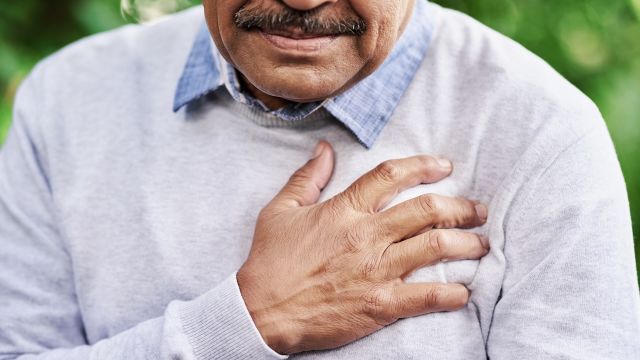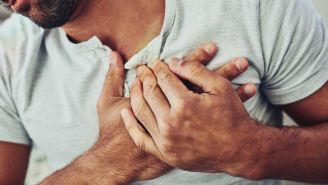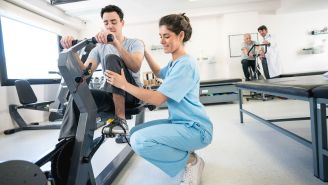Updated on August 15, 2024.
Heart attacks can come on suddenly, but the disease that causes heart attacks is often years in the making. A heart attack, also known as a myocardial infarction, occurs when a blockage in one or more of the arteries surrounding the heart (known as the coronary arteries) stops the flow of oxygen-rich blood to the heart. If the blockage isn’t quickly removed, the heart muscle begins to die. Every year approximately 805,000 people in the United States experience a heart attack, according to the Centers for Disease Control and Prevention (CDC).
Here’s what you need to know.
Heart attack causes and risk factors
Coronary artery disease (CAD, also called heart disease) is the most common cause of heart attacks. CAD is caused by a buildup of cholesterol deposits, called plaque, inside the arteries that surround the heart muscle. The buildup of plaque over many years is called atherosclerosis. (This can affect other arteries in the body and is also called "hardening of the arteries").
“Sometimes the plaque ruptures for reasons we don’t know and causes a blood clot,” says Muhammed Bhatti, MD, a cardiologist in Las Vegas, Nevada.
The clot can partially or fully block the flow of blood in the artery, says Dr. Bhatti. A fully blocked artery causes more damage. “It’s the extent of the blockage that causes the danger,” he says. Less common causes of a heart attack include a spasm or tightening of the coronary arteries that cuts off blood flow, or a spontaneous rupture (or dissection) of the artery.
You’re at increased risk for a heart attack if you smoke, have high blood pressure, have high cholesterol (a fat-like substance in the blood), are overweight, eat an unhealthy diet, are sedentary (physically inactive) or have high blood sugar due to diabetes or prediabetes. Metabolic syndrome—a dangerous combination of abdominal fat, high blood pressure, and high blood sugar—also increases your chance of a heart attack. Other factors include age (you’re more likely to have a heart attack if you’re a man over 45 or a woman over 55), a family history of heart attack, or if you’ve previously had one.
Symptoms of a heart attack
Chest pain is the most common symptom in both men and women, but women are likely to have other heart attack symptoms that may be more difficult to diagnose, says Bhatti.
In addition to chest pain, common symptoms of a heart attack include:
- Dizziness
- Sweating
- Nausea
- Shortness of breath
- Rapid or irregular heart beat
- Indigestion
- Unusual fatigue
- Anxiety
About one in five heart attacks, so-called silent heart attacks, has no symptoms.
Call 911 for heart attack symptoms
If you think you’re having a heart attack, immediately call 911, says Bhatti. Do not try to treat your symptoms before calling 911, because doing so may delay potentially life-saving treatment. The 911 operator may instruct you to chew one 325 mg aspirin, which may improve your chances of survival.
Do not drive yourself to the hospital or have someone else do so.
“If you’re having a heart attack, there’s no blood flow and your heart is dying, which can cause rhythm problems,” says Bhatti. “If that happens when someone is driving you to the hospital, they can’t help you. If it happens in an ambulance, they’ll be able to see that on the monitor and can shock you out of that rhythm.”
How a heart attack is diagnosed
Once at the hospital an electrocardiogram (a test that shows the rate and rhythm of your heart) can help healthcare providers (HCPs) determine whether you are having a heart attack and the extent of the damage to the heart. Blood tests can check for proteins that are released into the blood stream when the muscle tissue of the heart dies.
A coronary angiogram test may also be conducted. This procedure uses a thin tube called a catheter inserted into a blood vessel in your arm or groin to take a series of X-rays of the blood vessels of the heart. This test can show the inside of the coronary arteries to help find blockages.
Treatment and recovery after a heart attack
Immediate treatment usually consists of aspirin and medications called nitrates that reduce the workload on the heart. Morphine may be given to treat pain, and oxygen if you’re having trouble breathing. To open the blocked artery, you may need a stent, which is a metal tube that keeps the artery from closing, or a medication called a thrombolytic that breaks up the clot.
Some patients may need bypass surgery. This procedure which involves removing a vein or artery from another part of the body, usually the legs, and attaching one end of the vein or artery to the aorta, while the other is attached past the blocked section of the coronary artery that has caused the heart attack. This restores blood flow. (The aorta is the main blood vessel that leads out of the heart to the rest of the body.)
You’ll probably be on medication once you’re discharged from the hospital. These medications often include aspirin or other anticoagulants or anticlotting medications (also called blood thinners) to prevent more blood clots, ACE inhibitors to lower blood pressure, beta-blockers to decrease the strain on the heart, and statins to control cholesterol and reduce inflammation.
Bhatti says the sooner the blood vessel can be opened, the better the outcome.
“Any patient we suspect is having a heart attack, we try to open up the vessel within 90 minutes,” he says. “If the blood flow was restored and damage was minimal, the prognosis for recovery is excellent. Otherwise, if there’s too much damage, the patient may develop congestive heart failure." This occurs when the heart muscle can no longer pump blood effectively enough to meet the body's needs for oxygen.
Preventing a heart attack
The most important way to prevent a heart attack is not to smoke, according to Bhatti.
“Cigarette smoke contains toxins that probably cause inflammation in blood vessels,” he says. “These toxins also cause the buildup of plaque.”
Other important ways to prevent a heart attack include taking any medication as prescribed and getting regular exercise as your are able. Bhatti recommends 30 to 40 minutes of walking or biking per day, and a heart-healthy diet which is rich in fruits, vegetables, and lean protein, and low in saturated fat and low in added sugar and salt. (Saturated fat is the kind that is solid at room temperature, like butter.) "That means no processed foods and avoid refined sugars, refined carbs, and fried foods,” says Bhatti.







